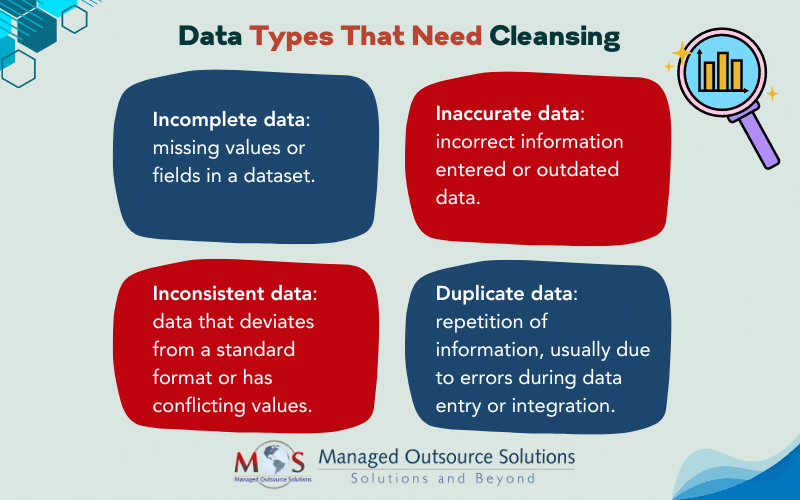Dirty data refers to any data that is inaccurate, incomplete, or inconsistent. It’s reported that companies believe at least 26% of their data is dirty and that they experience losses because of this. Businesses are increasingly turning to data cleansing companies to improve the quality of their data. This blog discusses the types and causes of dirty data, and steps for successful data cleansing.
Data Cleansing to Handle Different Types of Dirty Data
IBM estimated that bad data costs US companies around three trillion dollars annually. If not addressed, small errors can add up and have a huge impact on a company’s annual revenues.
Data cleansing can address different types of dirty data, such as:
Dirty data occurs due to various reasons:
Human errors during data entry: It’s reported that human error is responsible for over 60% of dirty data. Mistakes can occur when data is entered into the computer.
Data silos: Errors can occur when merging data from different sources. For instance, different departments have their own way of storing, handling, and formatting data. When data is moved from one department to the other, if there are data silos in place, this can cause dirty data.
System glitches or technical issues: System glitches or technical issues can introduce errors or inconsistencies into the dataset. For example, if an automated order processing system for handling customer orders develops a glitch, it can cause incorrect calculations and other problems.
Outdated information: If a business solely accumulates data without periodic reviews, email addresses and contact information may become outdated and ineffective. This can result in missed communication opportunities with customers and compromised decision-making in various areas.
Changes in data formats or standards: When data formats or standards are modified existing data may not align with the new specifications. This misalignment can result in data being improperly interpreted or rendered incompatible with the new standards.
What Data Cleansing Involves
The data cleansing process involves identifying and correcting or removing errors, inconsistencies, and inaccuracies within a dataset. Implementing data cleansing effectively can:
-
- Address missing data: Strategies include imputation (filling in missing values based on existing data) or removing incomplete records.
- Standardize data: Ensuring consistent formats, units, and values across the dataset.
- Correct inaccurate data: Reviewing and correcting inaccuracies or outdated information.
- Remove duplicates: Identifying and eliminating redundant records.
- Validate data: Verifying data against predefined rules or criteria.
- Standardize data: Converting data into a standardized format.
Steps to Navigate Data Cleansing Successfully
Successful data cleansing can greatly improve data quality, enhance decision-making, and ensure the reliability of business operations.
Here are the steps in a successful data cleansing process:
Define data quality goals
Start by clearly defining your data quality goals. Identify the specific issues you want to address, such as duplicate records, missing values, formatting errors, or inconsistent data. This will help you establish a clear direction for the data cleansing process.
Assess data quality
Conduct a comprehensive assessment of your dataset to identify the existing data quality issues. This involves examining data for errors, inconsistencies, outliers, and other anomalies. Use data profiling techniques, statistical analysis, and data visualization tools to gain insights into the quality of your data.
Establish data cleansing rules
Develop a set of data cleansing rules and criteria based on your data quality goals. These rules will guide the process of identifying and correcting or removing data errors. For example, you might define rules to identify and merge duplicate records, standardize formats, or validate data against predefined criteria.
Select data cleansing tools
Choose appropriate data cleansing tools that align with your specific requirements and budget. There are various commercial and open-source tools available that offer functionalities such as data parsing, standardization, deduplication, and validation. Select tools that can automate the cleansing process and handle large datasets efficiently.
Implement data cleansing
Implement the predefined data cleansing rules using the selected tools. This typically involves data preprocessing steps like filtering, transforming, and validating data. Apply the rules to identify and correct errors, remove duplicates, fill missing values, and ensure consistency across the dataset.
Validate and verify
After cleansing the data, perform thorough validation and verification processes to ensure the effectiveness of the cleansing efforts. Use data quality metrics, data profiling, and sampling techniques to assess the impact of the cleansing process on data quality. Verify that the data meets predefined quality standards and aligns with your desired outcomes.
Maintain records
Document the data cleansing procedures, rules, and any modifications made to the dataset. Maintain a record of the changes made during the cleansing process for future reference. Establish data governance practices to ensure ongoing data quality maintenance and regular cleansing activities.
Monitor and continuously improve
Data quality is an ongoing effort. Implement a monitoring system to regularly assess data quality and identify any emerging issues. Continuously improve your data cleansing processes by learning from past experiences, seeking feedback from data users, and incorporating best practices.
Remember that data cleansing is not a one-time activity. It should be integrated into your data management practices as a continuous process to maintain high-quality data. Regularly review and refine your data cleansing strategies to adapt to evolving business needs and changing data quality requirements.
Following the steps listed above can help you maintain the accuracy and reliability of your business’s information assets, though your primary goal. Getting external support is a practical and cost-effective option. Data cleansing services employ automated tools and processes to detect and rectify duplicate entries, incomplete records, and formatting issues. Partnering with an expert can help you maintain data quality and maximize the value derived from your information assets.
Don’t let dirty data hold you back! Take the first step to transform your data into a strategic asset.





